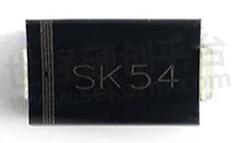What Is Shockettky?

The Schottky diode is named after its inventor, Dr. Schottky (Schottky), and SBD is the abbreviation of Schottky Barrier Diode (Schottky Barrier Diode, abbreviated as SBD). SBD is not made by the principle of contacting P-type semiconductor and N-type semiconductor to form a PN junction, but by using the principle of metal-semiconductor junction formed by contacting metal and semiconductor. Therefore, SBD is also called a metal-semiconductor (contact) diode or surface barrier diode, which is a kind of hot carrier diode.

Fig.1
A Schottky diode is a metal-semiconductor device made of a noble metal (gold, silver, aluminum, platinum, etc. A is the positive electrode and an N-type semiconductor B is the negative electrode, and the potential barrier formed on the contact surface of the two has rectification characteristics. Because there are a large number of electrons in the N-type semiconductor and only a small amount of free electrons in the noble metal, the electrons diffuse from B with high concentration to A with low concentration.
Obviously, there are no holes in metal A, and there is no diffusion of holes from A to B. As electrons continue to diffuse from B to A, the electron concentration on the surface of B gradually decreases, and the surface electrical neutrality is destroyed, thus forming a potential barrier, and its electric field direction is B→A. However, under the action of the electric field, the electrons in A will also produce a drift motion from A→B, thus weakening the electric field formed due to the diffusion motion. When a space charge region of a certain width is established, the electron drift movement caused by the electric field and the electron diffusion movement caused by different concentrations reaches a relative balance, forming a Schottky barrier.
Application Of Products

Fig.2
Schottky diode, also known as Schottky barrier diode (SBD for short), is a low-power, ultra-high-speed semiconductor device. The most notable feature is that the reverse recovery time is extremely short (can be as small as a few nanoseconds), and the forward voltage drop is only about 0.4V. It is mostly used as high-frequency, low-voltage, high-current rectifier diodes, freewheeling diodes, and protection diodes. It is also useful as rectifier diodes and small-signal detector diodes in microwave communication circuits. It is more common in communication power supplies, frequency converters, etc.
A typical application is in the switching circuit of the bipolar transistor BJT, by connecting the Shockley diode to the BJT to clamp, so that the transistor is actually close to the off state when it is in the on state, thereby increasing the switching speed of the transistor. This method is the technique used in the TTL internal circuits of typical digital ICs such as 74LS, 74ALS, 74AS, etc.
The biggest feature of Schottky diodes is that the forward voltage drop VF is relatively small. In the case of the same current, its forward voltage drop is much smaller. Plus it has a short recovery time. It also has some disadvantages: the withstand voltage is relatively low, and the leakage current is slightly larger. It should be considered comprehensively when choosing.
- +1 Like
- Add to Favorites
Recommend
- A 12V DC Lightning Protection Solution from Yint
- Yint Electronics Recommends Using a Varistor for Input Overvoltage Protection of Smart Meters
- Yint Electronics Provides Effective Circuit Protection for UWB Positioning Base Stations
- Yint Electronics MOV 14D561K, TVS SMBJ6.5CA P6SMBJ10CA for Power Line Carrier PLC Interface Circuit
- How To View The Importance Of Power Surges To The System?
- The Applications of PPTC Protection Devices in Wireless Electronic Products, Battery Packs, Chargers, Power Converters and Transformers
- Yint Electronics provides the SD/TF Memory Card Interface Solution
- Yint‘s ESDSR05-4 TVS Meet the Electrostatic Protection Design Of SIM Card Reading Circuit
This document is provided by Sekorm Platform for VIP exclusive service. The copyright is owned by Sekorm. Without authorization, any medias, websites or individual are not allowed to reprint. When authorizing the reprint, the link of www.sekorm.com must be indicated.






























































































































































































































































































































































































































































































































































































































































































































































































































